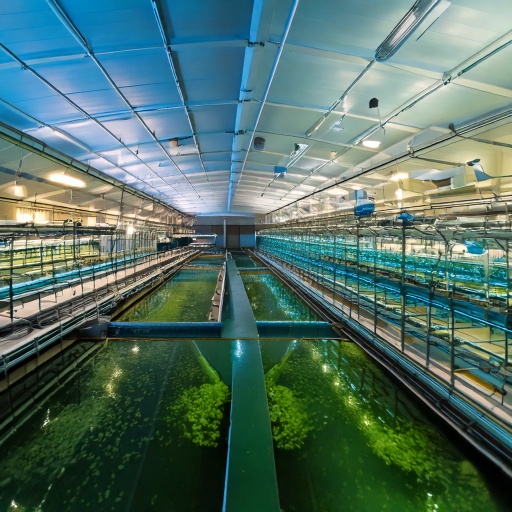Fish & Amphibian Farming (Aquaculture): Closing the High-Value Protein Loop
The Ecoladang Fish & Amphibian Farming unit utilizes advanced, controlled aquaculture and semi-aquatic systems to produce high-value aquatic and amphibian protein. Its strategic importance lies in its symbiotic relationship with the Insect Farm, consuming the locally generated insect meal to eliminate external feed costs. This integrated, closed-loop model ensures biosecurity, maximum resource efficiency, and predictable, year-round harvests of premium species.
1. Integrated Feed and Circular Economy
Our farming system is designed to leverage the internal resources of the Ecoladang ecosystem, resulting in superior efficiency, cost control, and verifiable sustainability.
The Zero-Cost Feed Loop
- Zero-Cost Primary Feed:The unit is directly supplied with high-protein insect meal from the on-site Insect Farming micro-farm. This eliminates the largest variable cost in conventional aquaculture—expensive, imported fishmeal and commercial feed—guaranteeing stable, long-term operational costs for all aquatic and amphibian life cycles.
- Waste Utilization: Processed fish effluent (nutrient-rich wastewater) can be safely utilized as a primary fertilizer source for the non-recirculating systems in the Hydroponics unit, creating a powerful nutrient synergy between the farms.
Resource Efficiency
- Recirculating Aquaculture Systems (RAS):We implement state-of-the-art RAS technology, which continuously filters and reuses water. This drastically reduces water waste and consumption, making the unit resilient to water scarcity and minimizing environmental discharge.

To maximize profitability, our focus is on robust, fast-growing species that command premium pricing in local and regional specialty markets, moving beyond low-margin commodity products.
- Premium Tilapia & Specialist Catfish:Cultivation centers on fast-cycle species known for excellent meat quality, such as specialized strains of Tilapia or high-demand local catfish variants.
- High-Margin Amphibians (Frogs): We cultivate specific frog species (e.g., high-demand regional varieties) known for extremely high margins and consistent demand within certain culinary communities (e.g., Chinese cuisine), providing a key differentiator for premium market access.
- Quality Assurance:The clean, closed environment, coupled with customized, high-quality feed (gut-loaded insect meal), ensures a superior, contaminant-free product that meets stringent culinary and export standards.
- Verifiable Biosecurity: The controlled, closed-loop environment acts as a natural quarantine, providing superior biosecurity compared to open pond or cage systems, minimizing the risk of disease outbreak and subsequent crop loss.

Operational success in aquatic and amphibian farming is highly dependent on instantaneous data and rapid response capabilities, which are managed entirely by the integrated PCDS.
Automated Environmental Management
- Water Quality Monitoring:Sensors continuously monitor critical water parameters, including Dissolved Oxygen (O2), pH levels, Ammonia (NH3), and temperature. This real-time data is essential for fish health and is fed directly to the PCDS core.
- Habitat Control: The PCDS manages climate for both pure aquatic RAS tanks and the semi-aquatic enclosures required for frog cultivation, maintaining optimal air and water conditions to maximize health and growth rate.
- Automated Feeding & Optimization: The PCDS utilizes AI models to optimize feeding schedules based on species, size, growth rate, and water temperature. This automated, precision feeding system minimizes waste and maximizes Feed Conversion Ratio (FCR).
Operational Scalability
- Remote Management:Franchisees and centralized support can remotely monitor the health and operational status of all tanks and enclosures, allowing for instant intervention to prevent potential disease or equipment failures.
- Rapid Deployment & Scalability:The modular design of the tank and enclosure systems allows for rapid, standardized expansion, ensuring the unit can scale quickly to meet fluctuating market demand.
The Strategic Advantage of Ecoladang Fish & Amphibian Farming
The Fish & Amphibian unit is the final, essential component in the Ecoladang protein complex. By transforming waste-derived insect meal into high-value protein using advanced, resource-efficient technology, it delivers a superior return on investment with minimized environmental risk.
Elimination of Feed Cost Sourcing high-protein feed (insect meal) internally removes the single largest operational cost in aquaculture, maximizing profit margins and insulating the business from global commodity price spikes.
Guaranteed Year-Round Yield The closed, climate-controlled RAS environment eliminates risks from weather, predation, and external contamination, ensuring predictable, scheduled harvests every single month.
Premium Market AccessFocusing on high-value Tilapia, Catfish, and specialized amphibians secures access to lucrative urban and culinary markets, ensuring the product commands a premium price point over generic, commodity seafood.
Highest Resource EfficiencyWater recirculation and waste conversion ensure this micro-farm operates with minimal ecological impact, aligning perfectly with strict ESG standards and making it a leader in sustainable protein production.
The Strategic Advantage of Ecoladang Fish Farms
The Fish Farm unit is the final, essential component in the Ecoladang protein complex. By transforming waste-derived insect meal into high-value protein using advanced, resource-efficient technology, it delivers a superior return on investment with minimized environmental risk.